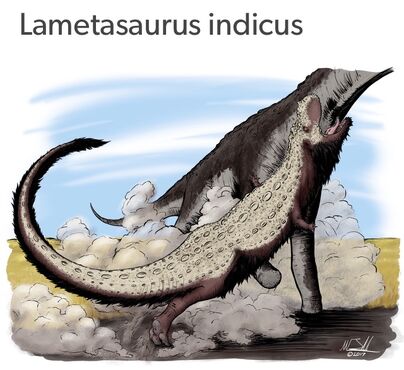m (Just one added sentence.) |
(/summary/) Tag: Visual edit |
||
| (5 intermediate revisions by 3 users not shown) | |||
| Line 1: | Line 1: | ||
| − | Lametasairus( |
+ | Lametasairus (Name meaning: "Lameta lizard") named for the Lameta Formation, Jabalpur, India, is the generic name given to a possible, dubious dinosaur - theropod species. Palentologist's do not know many things about this dino for example: They do not know wether it is a herbivore or a carnivore. Originally it indicated a possible chimera composed of several different animals. They were ground dwelling carnivores. [[File:18A1E73F-FB16-400E-9689-339380EDA6A3.jpeg|thumb|404x404px]] |
| ⚫ | |||
| ⚫ | Between October 1917 and 1919Charles Alfred Matley excavated fossils near Jabalpur.<sup>[2]</sup> In 1921 he reported the find in the "Carnosaur Bed" of what he considered to be two megalosaurians,theropod dinosaurs.<sup>[3]</sup> In 1923/1924 he named one of these as the type species''Lametasaurus indicus''. The generic name refers to the Lameta Formation, dating from the Maastrichtian, the specific name refers to India. However, Matley no longer identified it as a theropod but as a member of the Stegosauriainstead, which concept at the time also included the armoured dinosaurs today assigned to the Ankylosauria; at first Matley had seen it as a stegosaurian in the modern sense and even intended to name it as a species of ''Omosaurus''.<sup>[2]</sup>The type specimen consisted of a number of dermal scutes, a sacrum of at least five sacral vertebrae, a pelvis, atibia and teeth.<sup>[4]</sup> In 1933 Matley andFriedrich von Huene described some more remains collected by Barnum Brown,<sup>[2]</sup> thought to have been part of a tail club;<sup>[5]</sup> later this was shown to be a large osteoderm.<sup>[2]</sup> |
||
| ⚫ | However, in 1935 Dhirendra Kishore Chakravarti contested the interpretation as an armoured dinosaur. He claimed that the specimen was a chimera including titanosaurid armor, crocodileteeth and theropod hindlimb material.<sup>[6]</sup>In 1964 Alick Walker chose the scutes as the lectotype, thus removing the teeth and the bones from the type material.<sup>[7]</sup> The name ''Lametasaurus'' now designated the scutes only and was generally considered to |
||
| + | |||
| ⚫ | However, in 1935 Dhirendra Kishore Chakravarti contested the interpretation as an armoured dinosaur. He claimed that the specimen was a chimera including titanosaurid armor, crocodileteeth and theropod hindlimb material.<sup>[6]</sup>In 1964 Alick Walker chose the scutes as the lectotype, thus removing the teeth and the bones from the type material.<sup>[7]</sup> The name ''Lametasaurus'' now designated the scutes only and was generally considered to represen |
||
| + | |||
| + | t a member of the Nodosauridae. The pelvis and hindlimb bones have in 2003 been suggested to belong to''Rajasaurus''.<sup>[8]</sup> In 2008 Matthew Carranoe.a. discarded the possibility the scutes were ankylosaurian, stating they were probably titanosaurian or perhapsabelisaurid, in which latter case the species would possibly not have been a chimera in the first place and be a possible senior synonym of ''Indosaurus''and/or ''Rajasaurus''.<sup>[9]</sup> |
||
The type material has been lost, lacking a known inventory number, making it difficult to test the several hypotheses. The taxon is today commonly seen as a''nomen dubium''.<sup>[10]</sup> |
The type material has been lost, lacking a known inventory number, making it difficult to test the several hypotheses. The taxon is today commonly seen as a''nomen dubium''.<sup>[10]</sup> |
||
| Line 13: | Line 16: | ||
[[Category:Fossil taxa described in 1923]] |
[[Category:Fossil taxa described in 1923]] |
||
[[Category:Chimeras]] |
[[Category:Chimeras]] |
||
| + | [[Category:Dubious genera]] |
||
Revision as of 22:56, 7 June 2020
Lametasairus (Name meaning: "Lameta lizard") named for the Lameta Formation, Jabalpur, India, is the generic name given to a possible, dubious dinosaur - theropod species. Palentologist's do not know many things about this dino for example: They do not know wether it is a herbivore or a carnivore. Originally it indicated a possible chimera composed of several different animals. They were ground dwelling carnivores.

Between October 1917 and 1919Charles Alfred Matley excavated fossils near Jabalpur.[2] In 1921 he reported the find in the "Carnosaur Bed" of what he considered to be two megalosaurians,theropod dinosaurs.[3] In 1923/1924 he named one of these as the type speciesLametasaurus indicus. The generic name refers to the Lameta Formation, dating from the Maastrichtian, the specific name refers to India. However, Matley no longer identified it as a theropod but as a member of the Stegosauriainstead, which concept at the time also included the armoured dinosaurs today assigned to the Ankylosauria; at first Matley had seen it as a stegosaurian in the modern sense and even intended to name it as a species of Omosaurus.[2]The type specimen consisted of a number of dermal scutes, a sacrum of at least five sacral vertebrae, a pelvis, atibia and teeth.[4] In 1933 Matley andFriedrich von Huene described some more remains collected by Barnum Brown,[2] thought to have been part of a tail club;[5] later this was shown to be a large osteoderm.[2]
However, in 1935 Dhirendra Kishore Chakravarti contested the interpretation as an armoured dinosaur. He claimed that the specimen was a chimera including titanosaurid armor, crocodileteeth and theropod hindlimb material.[6]In 1964 Alick Walker chose the scutes as the lectotype, thus removing the teeth and the bones from the type material.[7] The name Lametasaurus now designated the scutes only and was generally considered to represen
t a member of the Nodosauridae. The pelvis and hindlimb bones have in 2003 been suggested to belong toRajasaurus.[8] In 2008 Matthew Carranoe.a. discarded the possibility the scutes were ankylosaurian, stating they were probably titanosaurian or perhapsabelisaurid, in which latter case the species would possibly not have been a chimera in the first place and be a possible senior synonym of Indosaurusand/or Rajasaurus.[9]
The type material has been lost, lacking a known inventory number, making it difficult to test the several hypotheses. The taxon is today commonly seen as anomen dubium.[10]